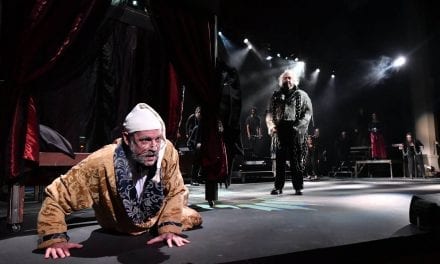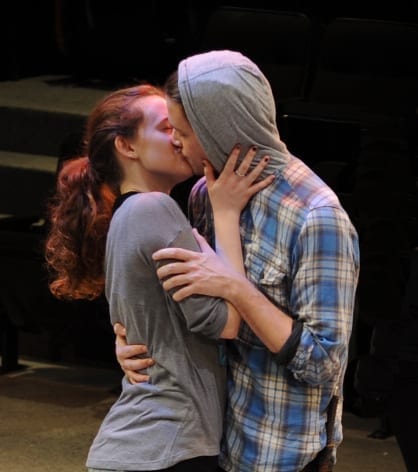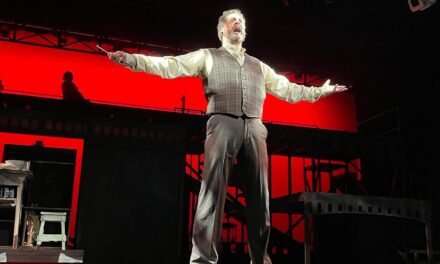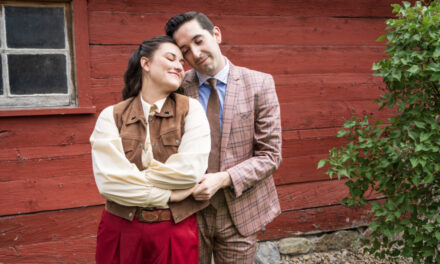OREM — What should you do when a fear keeps you from being who you want to be or going where you want to go? Do you run away? Pretend the fear doesn’t exist? Or use your smarts? Thinking through fear and devising a plan is what Wiley and the Hairy Man is all about.
When the UVU Department of Theatrical Arts’ engaging children’s theater production begins, we meet Wiley, a young fatherless boy who is plagued by nightmares of a spooky demon—“He done got your pappy, and he’s gonna get you!” But promised by his Mammy, the best conjure-woman of Alabama’s mysterious Tombigbee swamplands, that if Wiley can “Outwit the Hairy Man three times, he won’t scare you ever again.”
Playwright Suzan Zeder’s script, which earned the prestigious International Association of Theater for Children and Young People Outstanding Play Award, allows ample room for creativity, and director John Graham takes full advantage of the play’s possibilities. While the script calls for multiple chorus members, how the players are used is left up to the director.
When you enter the university’s Noorda Theatre, Jason Sullivan’s dark and moody set surrounds you and suggests a forbidden place deep inside a misty swamp: twisted tree trunks, deep-green moss, entangled vines—and Wiley’s small backwoods cabin and teetering dock at the swamp’s edge. Three stilt-wearing members of the play’s chorus, camouflaged as trees nestled within the set for the entire show and tower over other company players. They provide swamp sounds to form a multipart chorale of hisses, howls, and bullfrog chirps that drift in from all around you. This soundscape and the voices from the other formless, clad-all-in-black chorus players add to the mysterious atmosphere as they roam about and help dramatize the details of the tale. To signal the trickster Hairy Man’s arrival, the chorus rhythmically chants, “Stampin’, stompin’, coming through the trees, shufflin’ in the swamp grass, blowin’ in the breeze….” And they warn us that “When the Hairy Man gets mad, that’s bad.” The chorus also transforms into props as they are needed, by crouching down as a breakfast table, or emblazing a fire under Mammy’s stove pot with gloves of flame-hued silk scarves. While the vocalization from the chorus is fine, the stark production would benefit from the drum beats and other percussion instruments that are often used to underscore the origins of this African-American folktale.
Each character is well played by the 15-member cast, although their frenetic pacing hinders the play’s dramatic tension, especially when Wiley confronts his demons. I quickly warmed to Katie Sue Sullivan; she commands the stage as the lively, down-to-earth Mammy. Though her trembling characterization is on target, it appears that Anne Marie Betts was cast largely on her diminutive stature: She struggles to project her lines to engage us as the spunky Wiley. The team of Tasha Hickman, Audrey Kearl, Mandy L. Lyons, Marc Navez, and Collin Lee Thomas III take earthy elements from the set to form the threatening puppet Hairy Man and other swamp creatures that are frightening and yet also whimsical. Daniel Anderson, Morgan Fenner, Brian Grob, Nick Grossaint, Jessica Gunson, Kelsey Kendall, and Heather Diana Murdock comprise the hard-working chorus. Wiley’s ever-faithful hound dog is also an essential character—because “The Hairy Man can’t stand no dogs”—and is played by Emily Griffith, who energetically scampers on all fours.
The tattered, deep-colored costumes were created by Jared Davis, and the hyperactive lighting design is by Casey Price. The cast worked with George Grant, a professional percussionist and vocalist, to perfect the swamp sounds and rhythmic chants.
It’s interesting to note that after Wiley and the Hairy Man was written, what has come to be known as the Wiley Test is used to judge whether heroes solve their own problems. Playwright Suzan Zeder recognized that characters in children’s stories often don’t solve their own challenges without an adult protector stepping in. “I wanted to write a play about kinds of fears that children face, alone in the dark,” she has said. “I wanted to write a play about magic—good magic and bad—and, most importantly, the magic that all of us have somewhere deep inside us.” The eight-page Learning Stage syllabus provided at the UVU production reminds us that Cinderella only solves a problem with the wave of Fairy Godmother’s wand. But Mammy tells Wiley that he must look fear in the face and then outsmart it: “Wiley! There ain’t no magic nor dog strong enough to keep you safe every minute. You gotta learn how to do it youself.”





